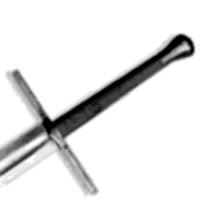Vier Leger warmly welcomes it's latest additions - two amazing new Albion Swords!
First up is The Liechtenauer - a steel training blade with unequaled style. Its design is a great balance between robust feel and flex at the point. This is a very fast weapon with an alive feel in motion, which is further enhanced by its long grip and sturdy cord wrap.
After a fellow swordsman allowed us a first-hand examination, and told tales of its ability to hold its own against other training blades with minimal nicks and scratches, we were sure that we wanted to add this piece to our collection.
Next up is The Talhoffer - our first sharp, acquired with test cutting in mind. This blade has an aggressive feel that loves to move forward, and a point which is very threatening!
Aesthetically, there is beauty in the diamond cross-section of the blade, and a powerful look to the waisted grip. This is a very intimidating sword, every bit as inspired as it is lethal.
And here's the kick to the uninitiated - the swords weigh approximately 1.5 kilos each. Quite a shock to those expecting a medieval sword to be a heavy, clumsy weapon, wielded only through brute force.
To the contrary, these blades are quick and reactive, making them well designed for their purpose of performing quick cuts and thrusts, and allowing for fast follow-up and recovery movements.
Never held a sword before? Interested to see how they were employed? Contact us - we'd love to invite you to see them first hand.
Follow the link for more from the team at Albion Swords, including their awe-inspiring catalogue and amazing customer testimonials.
For more on our favourite sharp-pointy-one, read a review of The Talhoffer from myArmoury.com with some great pics!






